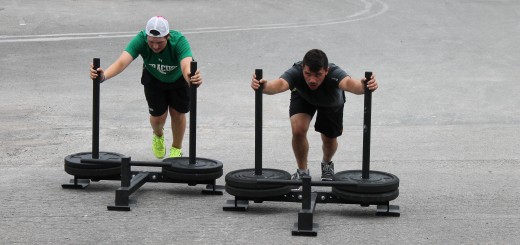Massive Gains, Minimal Body Fat & Glenn Pendlay
Glenn Pendlay is an Olympic Weightlifting Coach. He trains among other things, NFL Combine-ready athletes. He believes in whole-body exercises, not isolation movements. He shares his hypertrophy secrets here.
Too Much Muscle

Glenn Pendlay, noted Olympic weightlifting coach, has a problem: His athletes are building too much muscle, too fast.
The weightlifters are growing right out of their weight classes… while losing body fat.
They’re not training for hypertrophy, but they’re gaining muscle much faster than people who are. People like you.
And they’re doing it by not training like bodybuilders.
Do you feel sorry for Pendlay and his “problem?” We don’t either. So when Christian Thibaudeau, Tim Patterson, and I called him, we didn’t tell him we were sorry to hear about his little accidental hypertrophy issue. Nope, weinterrogatedhim about it.
We wanted to know how his athletes were training. We wanted to hack his system and pass that info on to you. This is what we learned.
 Testosterone Nation: Your athletes, whether they’re Olympic lifters or football players getting ready for the NFL Combine, are known for putting on muscle very quickly. But you’re not a hypertrophy coach per se.
Testosterone Nation: Your athletes, whether they’re Olympic lifters or football players getting ready for the NFL Combine, are known for putting on muscle very quickly. But you’re not a hypertrophy coach per se.
Glenn Pendlay: I’m not a bodybuilding coach. I coach high-level athletes. For me, it’s never been about how you look but about how much you lift or how fast you run or how high you jump. Still, I’ve often had trouble keeping an athlete down in his weight class.
Anybody can “bulk up.” Eat a ton of food, drink a bunch of milk, do your major exercises like squats and bench presses and rows and deadlifts and military presses… it’s just not that hard to gain 20 pounds with at least some of it being muscle. Most people that “can’t” do it have simply not done the program correctly.
Of course, done that way you don’t end up looking good naked. And you usually don’t end up running faster, jumping higher, or having the ability to close the cushion in the first five yards off the line if you’re a football receiver. What we do, the way we train, seems to increase lean body mass, decrease body fat, and definitely adds to your ability to run and jump and do athletic things.
If you’re trying to get someone to be as good as they can be in the 94 kilo class – where 207 pounds is the most they can weigh – the object is to get them as strong as possible within that weight class. That means being very lean because the more body fat you have the less muscle you can carry and still be in the weight class. And it means making any muscle that is addedvery functional: muscle that adds to performance and not just to the bicep measurement.
T NATION: It’s a little frustrating to hear that a lot of athletes build very muscular and lean bodies without ever “bodybuilding” in the traditional sense of the word. Train for performance, look like a bodybuilder, or at least a drug-free bodybuilder.
 Pendlay: If you look at the physiques of a lot of the guys I coach, whether they’re weightlifters or in the NFL, they’re not professional bodybuilders, but they possess the physiques that would be looked at as ideal by nine out of ten people who don’t want to use drugs. They just want to look good with their shirts off.
Pendlay: If you look at the physiques of a lot of the guys I coach, whether they’re weightlifters or in the NFL, they’re not professional bodybuilders, but they possess the physiques that would be looked at as ideal by nine out of ten people who don’t want to use drugs. They just want to look good with their shirts off.
Look at the average running back in the NFL – he has a very muscular, very lean, functional physique. Most people will see that physique as more realistic. They don’t want to do the drugs necessary to look like a pro-bodybuilder.
In fact, they’d preferto look like the running back rather than a pro-bodybuilder. Ninety-nine percent of people want to look like Jon North or T.J. Ward.
Last year when we did T.J.’s Combine prep, he gained 20 pounds of lean body mass. That guy looks scary without his shirt, just densely muscular and lean.
Methods & Metabolism
T NATION: Okay, let’s get to it. How are these guys gaining muscle so quickly?
Pendlay: When weightlifters start doing a ton of extra workouts that are concentric-only, they have a problem: they grow out of their weight class. And that’s with lean muscle, not fat.
We do very frequent training. We have a certain number of workouts per week that are very high intensity. We have only a couple of workouts per week that involve heavy eccentric loading, something like squatting.
We do very frequent, very high intensity, concentric loading. We do it for weightlifters, we do it for professional athletes, we do it for guys getting ready for the NFL Combine… we do it for everybody.
You get stronger and you gain lean body mass without gaining fat. You train like that, that often, then it’s actually difficult to gain fat; your metabolism is going like a furnace.
T NATION: You’ve talked in our forums about how this is related to hormones. Can you elaborate?
Pendlay: The research I did getting my master’s degree was all hormonal based. I’m always looking at how training influences the hormonal response, and, if you get it right, how hormonal response influences the results you get from training. That made a huge impact on how I’ve designed my training philosophy.
The whole-body type of workout, where you’re doing big, stressful exercises, stimulates a powerful hormonal response. That’s one of the reasons why people who aren’t on drugs get the most benefits from a completely different training style than those who are on drugs.
Someone who’s on drugs already has all the testosterone his system can handle. Someone who’s not on drugs needs to train in a way that stimulates his body’s production of hormones.
T NATION: That makes sense.
Pendlay: If you’re a pro-bodybuilder who’s taking the things that pro-bodybuilders take, then you don’t have to train the same way or worry about the same things as your average 25-year old guy who wants to build muscle and isn’t going to take drugs to do it. Those are two completely different systems of training.
What we’re talking about is doing things that stimulate the whole body more. You’re not doing isolation work; you’re not coming in and doing curls and blasting your biceps once a week with 20 sets. Instead you’re doing big exercises, leaning towards a whole-body workout.
Not everyone needs to do a whole-body workout, but they certainly don’t need to do chest one day, biceps the next, etc. Whole-body workouts or upper/lower splits are the answer.
You’re training more frequently, and as you get into better shape your goal is to start including “extra” workouts where you do very explosive, fast movements and, generally, concentric-only movements.
 T NATION: What does your upper/lower split look like?
T NATION: What does your upper/lower split look like?
Pendlay: My favorite split is squatting and pressing on Monday and Thursday. Then, on Tuesday and Saturday, we pull. That includes variations of the snatch and clean, as well as pull-ups and rows.
T NATION: How often are your athletes training?
Pendlay: My best athletes are in the gym twice a day, every day, and every single workout they’re working their hips, their backs, and their legs.
Regular people may not be able to always do that, but that’s the ultimate expression of what I’m talking about. What the regular guy can do is build towards that. He can look at what these athletes do and copy it to the best of his ability in the time that he has in the day.
The Best O-Lifts and the Push Press
T NATION: Okay, what’s one lift the hypertrophy-focused guy needs to learn from the Olympic-lifting world?
Pendlay: Either cleans or snatches. Preferably both. If you can’t do a full snatch, then do a power snatch. Do some sort of explosive pull, then drop the bar. If you can’t drop the bar in your gym, then at least lower it in a way that you’re not getting a huge eccentric load.
For upper body development, people should focus more on push presses, where the weight moves fast and explosively. I want people push-pressing every week.
There’s also a ton of value for the average guy who wants to get more muscular to pull a sled or push a Prowler. Everyone who wants hypertrophy should emphasize those things more than they do now.
T NATION: Break down the push press for us. Why should the bodybuilder use it instead of, say, a military press?
Pendlay: The push press has more carryover to pressing in general – bench press etc. – than any other upper body exercise. Show me a guy who can push press a big weight and he’s going to be able to excel at any other pressing movement, even if he’s never done it before.
A big bench presser doesn’t get that same carryover. I don’t want to have 400-pound bench pressers who can’t do anything else. The guy who can do heavy push presses doesn’t have that problem. He’s strong at everything.
And that can’t be done with the strict military press either. It’s too hard to get it moving. You have such a weak point at the start that it limits the amount of weight you can use.
With a push press, you can put 10 to 20% more weight over your head. You’re forced to develop the ability to recruit those muscle fibers very quickly because you’re pushing the bar off your shoulders with your legs and then your arms have to come into play, fast, so it doesn’t stall. The ability to do that is very, very valuable.
Second, with the push press there’s just a huge overload at the top. That last six inches at the top is like doing a partial. That has a powerful effect on the body.
T NATION: Wow, time to start push pressing more often! Give us the important points of how you want to see people push press.
Pendlay: They have to rack the bar correctly. Most people rest it on their clavicles, but what they need to do is shrug their shoulders up, putting their elbows slightly forward so the bar is resting on their deltoids. Then they have to stay on their heels and use and dip and drive.
After the leg drive, they have to push with their arms immediately, not pause for three seconds. Think rate of force production. It’s also very important to end with the weight behind your head, not in front of it. At the very least, a vertical line dropped from the bar should pass behind the ears, and you should pause momentarily at the top, every rep.
Speed Kills
 T NATION: Explosive training is making a comeback, so to speak, in hypertrophy training. Why exactly?
T NATION: Explosive training is making a comeback, so to speak, in hypertrophy training. Why exactly?
Pendlay: Explosive movements teach your muscles to “turn on.” Everybody should do explosive movements!
If you get better at explosive movements then you’re going to get more out of your other training. If you get better at jumping on a box then you’re going to get more benefit from squatting because your nervous system is going to be tuned up to utilize every available motor unit.
If you can turn on an extra 10 or 20% of motor units when you’re squatting, you’re going to get more benefit out of it. The easiest form of explosive training is to just jump on a plyo box.
T NATION: Give us an example of explosive training.
Pendlay: I’m looking out my office window right now. I see football players doing explosive, clap-style push-ups. What we do is, we make two stacks of two 25 kilo bumper plates. They do a push-up explosively and land with their hands on the bumper plates, about five or six inches off the ground. From there they push up again and land back on the floor.
That type of exercise is a huge complement to bench-pressing if your goal is to have a bigger chest and shoulders.
I see some other guys doing a medicine ball drill where one kid is standing on a box and throwing a ten-pound ball at another kid who’s lying on the floor. He throws the ball back up as fast as he can, no pause. Again, it’s sort of a bench press movement.
Bench presses are slow and heavy. The push-up drill is faster since you’re using only body weight. Then you have the med ball drill, which is light and fast. The lesson:You need to train at different speeds. From heavy, heavy, slow bench presses to throwing a ten-pound medicine ball as fast as you can.
Put all this together and what does it mean? It means that we get a guy who weighs 180 with a 30-inch vertical and pretty soon he weighs 200 with a 35-inch vertical… and he’s leaner. If he’s a football player then he’s going to be able to push people off the line. A 500 pound bench press isn’t going to do him much good if he’s slow.
He’s not only added muscle, he’s ramped up his nervous system. It allows him to use the muscle he has more effectively. He doesn’t just get bigger. He gets bigger and faster and stronger, all at the same time.
T NATION: Train at different speeds. Got it. And you break that down into three speeds, basically?
Pendlay: Yes. The guy who’s having trouble getting bigger and stronger and leaner is going into the gym and training one speed. What he needs to do is train at a variety of speeds: explosive, super explosive (medicine ball), medium-level plyos (body-weight box jumping), and alsodo squats and bench presses.
He’ll look better and be a better athlete. In athletics, speed kills. The Olympic lifts are a big part of training at different speeds. They’re in between deadlifting and jumping.
The Rule and the Row
T NATION: Any general rule with the Olympic lifts for those of us not training under the watchful eye of a coach?
Pendlay: If you miss the lift three times, stop. No matter how good you feel. Three strikes and you’re out. Also, use the Internet. There are a number of pretty good tutorials on how to learn the lifts.
T NATION: Not many coaches have exercises named after them. You do. What are Pendlay Rows?
Pendlay: Well, I didn’t give them this name myself. Someone else started calling them that and it kind of got traction.
Basically, this came about because I advocated doing rows in such a way as to keep the back parallel or near parallel to the floor the whole lift, return the bar to the floor between each rep, and explosively attempt to flex the thorasic spine on each rep. Very different than a standard barbell row.
T NATION: Any final tips for the T NATION audience?
Pendlay: One way or another, you need to be able to explosively lift a bar and drop it.
And if you can figure out a way to train more frequently, then you’ll get better results. Period. Olympic lifts either have no eccentric component or a very small eccentric component, so you can do them pretty damn often. And “pretty damn often” means better results.
Lastly, I’ve always said that people do too damn many exercises, and they don’t concentrate on the ones they do correctly. Take just about any college strength program for football. You’d be better off if you randomly crossed out half the exercises, then spent your time doing the ones that are left correctly and with focus.
Original Article by: Chris Shugart at T-Nation





